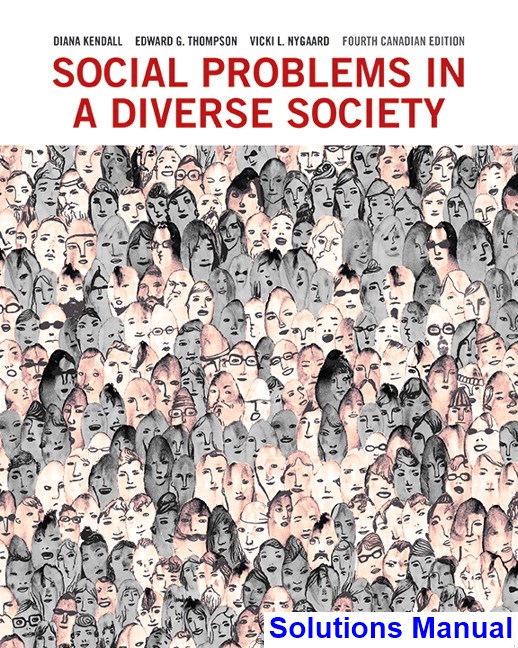This is completed downloadable of Social Problems in a Diverse Society Canadian 4th Edition Kendall Solutions Manual

Product Details:
- ISBN-10 : 0205885756
- ISBN-13 : 978-0205885756
- Author: Kendall
Learning about social problems can be a highly rewarding experience. Although we live in challenging times, a course on social problems provides an excellent avenue for developing critical thinking skills and for learning how to use sociological concepts and perspectives to analyze specific social concerns ranging from war and terrorism, media concentration, drug addiction, and violence to the inequalities of racism, sexism, classism, ageism, homophobia, and ableism.
The fourth Canadian edition of Social Problems in a Diverse Society focuses on the significance of racialization and ethnicity, age, sexual orientation, class, ability,and gender in understanding social problems in Canada and around the globe. Throughout the text, people – especially those from marginalized groups―are shown not merely as “victims” of social problems, but also as individual actors with agency who resist discrimination and inequality and seek to bring about change in families, schools, workplaces, and the larger society.
Table of Content:
- Chapter 1 Studying Social Problems in the Twenty-First Century
- What is a Social Problem?
- Why Study Social Problems?
- The Sociological Imagination and Social Problems
- Using Social Theory to Analyze Social Problems
- The Functionalist Perspective
- Manifest and Latent Functions
- Dysfunctions and Social Disorganization
- Applying the Functionalist Perspective to the Problem of Homicide
- The Conflict Perspective
- The Value Conflict Perspective
- Critical-Conflict Perspective
- Applying the Conflict Perspective to the Problem of Homicide
- The Interactionist Perspective
- Labelling Theory and the Social Construction of Reality
- Applying Interactionist Perspectives to the Problem of Homicide
- Feminist Perspectives
- Applying Feminist Perspectives to the Problem of Homicide
- Using Social Research Methods to Study Social Problems
- Field Research
- Survey Research
- Secondary Analysis of Existing Data
- Social Change and Reducing Social Problems
- Microlevel Attempts to Solve Social Problems
- Seeking Individual Solutions to Personal Problems
- Mid-Range Attempts to Solve Social Problems
- Groups that Help People Cope with Their Problems
- Grassroots Groups that Work for Community-Based Change
- Macrolevel Attempts to Solve Social Problems
- Working through Special-Interest Groups for Political Change
- Working through National Social Movements to Reduce Problems
- Summary
- Key Terms
- Questions for Critical Thinking
- Chapter 2 Wealth and Poverty: Canadian and Global Economic Inequities
- Wealth and Poverty in Global Perspective
- Analyzing Inequality in Canada
- Wealth and Income Inequality
- The Canadian Lower Class
- Poverty in Canada
- Age, Family Structure, Sex, Immigration, and Indigenous Status
- Consequences of Poverty
- Health and Nutrition
- Housing
- Education
- How Canada Deals with Poverty
- Social Welfare in Canada
- Breaking the Cycle of Poverty
- Bring Social Programs into the 21st Century
- Self-Esteem
- Training for the Jobs of the Future
- Perspectives on Poverty and Class Inequality
- The Symbolic Interactionist Perspective
- The Structural Functionalist Perspective
- The Conflict Perspective
- Feminist Perspectives
- How can Poverty be Reduced?
- What Can you Do?
- Summary
- Key Terms
- Questions for Critical Thinking
- Chapter 3 Racism and Ethnic Inequality
- Racism and Ethnic Inequality as a Social Problem
- What are Ethnicity, “Race,” and Racialization?
- Historical and Political Roots of “Race”
- The Meaning of Majority and Minority Groups
- White Privilege and Internalized Dominance
- The Special Case of Indigenous Peoples
- Racism, Prejudice, and Discrimination
- Historical Roots of Racism
- The Many Forms of Racism in Canadian Society
- Interpersonal Racism
- Institutional Racism
- Societal Racism
- Perspectives on Racialized and Ethnic Inequality
- The Symbolic Interactionist Perspective
- The Functionalist Perspective
- The Conflict Perspective
- Feminist and Anti-Racist Perspectives
- How Can Racialized and Ethnic Inequalities be Reduced?
- What Can you Do?
- Summary
- Key Terms
- Questions for Critical Thinking
- Chapter 4 Gender Inequality
- Violence Against Women
- Gender Inequality as a Social Problem
- Defining Sex and Gender
- Biological and Social Bases of Gender Roles
- Gender Inequality and Socialization
- Peers and Gender Socialization
- The Media and Gender Socialization
- Contemporary Gender Inequality
- The Gendered Division of Paid Work
- The Wage Gap
- Sexual Harassment
- The Glass Ceiling and the Glass Escalator
- The Double Shift
- Perspectives on Gender Inequality
- The Interactionist Perspective
- The Functionalist Perspective
- Conflict Perspectives
- Feminist Perspectives
- How Can Gender Inequality be Reduced?
- What Can you Do?
- Summary
- Key Terms
- Questions for Critical Thinking
- Chapter 5 Inequality Based on Age
- Characteristics of Later Maturity and Old Age
- Problems Linked to Being Elderly
- Ageism and Age-Based Stereotypes
- Workplace Discrimination
- Retirement: Income Security and Leisure Activities
- Health, Illness, and Health Care
- Victimization
- Family Problems and Social Isolation
- Housing Patterns and Long-Term Care Facilities
- Death and Dying
- Perspectives on Aging and Social Inequality
- The Functionalist Perspective
- The Interactionist Perspective
- The Conflict Perspective
- The Feminist Perspective
- Is There a Solution to Age-Based Inequality?
- What Can you Do?
- Summary
- Key Terms
- Questions for Critical Thinking
- Chapter 6 Inequality Based on Sexual Orientation
- Nature and Extent of Inequality Based on Sexual Orientation
- Ideological Bases of Inequality Based on Sexual Orientation
- Religion and Sexual Orientation
- Law and Sexual Orientation
- Discrimination Based on Sexual Orientation
- Victimization and Hate Crimes
- Perspectives on Sexual Orientation and Social Inequality
- Interactionist Perspectives
- Functionalist and Conflict Perspectives
- Feminist and Postmodern Perspectives
- How Can Inequalities Based on Sexual Orientation be Reduced?
- What Can You Do?
- Summary
- Key Terms
- Questions for Critical Thinking
- Chapter 7 Pornography and the Sex Trade in Canada
- Prostitution in Historical and Global Perspective
- The World’s Oldest Profession?
- The Global Sex Industry
- Prostitution in Canada
- Some Characteristics of Prostitution in Canada
- The Extent of Prostitution in Canada
- Prostitution and Age, Class, Education, Racialization, and Ethnicity
- A Closer Look at “Johns”
- Perspectives on Prostitution
- The Functionalist Perspective
- The Interactionist Perspective
- Conflict and Feminist Perspectives
- Pornography
- The Social Construction of Pornography as a Social Problem
- The Nature and Extent of Pornography
- Research on Pornography
- Pornography and Age, Gender, Class, Racialization, and Ethnicity
- The Future of Pornography and the Sex Industry
- What Can You Do?
- Summary
- Key Terms
- Questions for Critical Thinking
- Chapter 8 Addictions
- Drug Use and Abuse
- Defining Drug Abuse
- Drug Addiction
- Alcohol Use and Abuse
- High Alcohol Consumption and Gender and Age
- Alcohol-Related Social and Health Problems
- Driving and Drinking
- Family Problems
- Tobacco (Nicotine) Use as a Social Problem
- Prescription Drugs, Over-The-Counter Drugs, and Caffeine
- Prescription Drugs
- Over-the-Counter Drugs
- Caffeine
- Illegal Drug Use and Abuse
- Marijuana
- Stimulants
- Cocaine and Crack
- Depressants
- Narcotics
- Hallucinogens
- Inhalants
- Overall Harm from Drug Use
- Gambling and Problem Gambling
- Types of Gamblers
- Gambling and Gender, Age, Income, and Marital Status
- Problem Gambling and Province, Gender, Age, Marital Status, Education, and Income
- Gambling-Related Social Problems
- Explanations of Addictions
- The Interactionist Perspective
- The Functionalist Perspective
- The Conflict Perspective
- The Feminist Perspective
- The Future of Addictions
- Prevention Programs
- Treatment Programs
- The Medical Treatment Model
- The Therapeutic Community
- What Can You Do?
- Summary
- Key Terms
- Questions for Critical Thinking
- Chapter 9 Crime and Criminal Justice
- Crime as a Social Problem
- Problems with Official Statistics
- Defining Crime and Delinquency
- Types of Crimes
- Violent Crime
- Homicide
- Characteristics of Victims and Accused
- Sexual Assault
- Characteristics of Victims and Accused
- Gang Violence
- Hate Crime
- Property Crime
- Crime Comparisons between Canada and the United States
- Occupational (White-Collar) Crime
- Corporate Crime
- Organized Crime
- Youth Crime
- Sociological Explanations of Crime
- The Functionalist Perspective
- The Conflict Perspective
- The Interactionist Perspective
- Feminist Perspectives
- The Criminal Justice System
- The Police
- The Courts
- Punishment and the Prisons
- Restorative Justice
- What Can You Do?
- Summary
- Key Terms
- Questions for Critical Thinking
- Chapter 10 Health, Illness, and Health Care as Social Problems
- Health and Illness as Social Problems
- Acute and Chronic Diseases
- Sex and Gender, Class, and Indigenous Status
- Disability
- HIV/AIDS
- Obesity
- Mental Illness as a Social Problem
- Treatment of Mental Illness
- The “Crisis” in Canadian Health Care
- Development of the National Health Care System
- Current Issues in the Health Care System
- Accessibility and Wait Times
- Electronic Health Records (EHRs)
- Costs of Care
- Supply and Demand of Health Care Professionals
- Quality of Care
- Perspectives on Illness and Health Care Problems
- The Functionalist Perspective
- The Conflict Perspective
- The Interactionist Perspective
- The Feminist Perspective
- What Can You Do?
- Summary
- Key Terms
- Questions for Critical Thinking
- Chapter 11 The Changing Family
- The Nature of Families
- Changing Family Structure and Patterns
- Are Canadian Families in Decline?
- Changing Views on Marriage and Families
- Perspectives on Family-Related Problems
- The Functionalist Perspective
- The Conflict Perspective
- The Feminist Perspective
- The Interactionist Perspective
- Diversity in Intimate Relationships and Families
- Singlehood
- Postponing Marriage
- Common-Law or Cohabitation
- Living Apart Together (LAT)
- Dual-Earner Marriages
- Comparing Two-Parent and One-Parent Households
- Child-Related Family Issues
- Reproductive Freedom, Contraception, and Abortion
- Infertility and New Reproductive Technologies
- Adoption
- Parenting Style
- Teen Pregnancies and Unmarried Motherhood
- Divorce and Remarriage
- Domestic Violence
- Child Abuse
- Intimate Partner Violence
- Social Responses to Intimate Partner Violence
- Family-Related Problems in the 21st Century
- What Can You Do?
- Summary
- Key Terms
- Questions for Critical Thinking
- Chapter 12 Problems in Education
- Perspectives on Education
- Functionalist Perspectives
- Conflict Perspectives
- Interactionist Perspectives
- Feminist Perspectives
- Problems in Primary and Secondary Education
- What Can be Done about Educational Performance?
- Educational Opportunities and Ascribed Statuses in Education
- Bullying, School Violence, and Cyber-bullying
- Residential Schools
- Problems in Post-Secondary Education
- Increased Costs and Inadequate Governmental Support
- Commercialization of Post-Secondary Education
- Educational Opportunities and Gender, Ethnicity, and Indigenous Status
- Online Education: MOOCs (Massive Open Online Courses)
- The Economic Benefit of Post-Secondary Education
- Educational Goals for the 21st Century
- What Can You Do?
- Summary
- Key Terms
- Questions for Critical Thinking
- Chapter 13 Problems in the Globalized Economy and Politics
- Modern Economic Systems and the Underground Economy
- Problems in the Global Economy
- Inequality Based on Uneven Economic Development
- Transnational Corporations and Canada
- Problems in the Canadian Economy
- Concentration of Wealth
- Corporate Welfare
- The National Deficit and Debt
- Consumer Debt
- Unemployment
- Problems in political Participation Around the World
- Problems in Canadian Politics
- Voter Apathy
- Confidence in Parliament
- Perspectives on the Political Economy
- The Functionalist Perspective
- The Conflict Perspective
- The Symbolic Interactionist Perspective
- Feminist Perspectives
- Problems in the Political Economy in the 21st Century
- What Can You Do?
- Summary
- Key Terms
- Questions for Critical Thinking
- Chapter 14 Problems in the Media
- The Importance of the Media in Comtemporary Life
- The Political Economy of Media Industries
- Media Ownership and Control
- Problems Associated with Convergence
- Global and Canadian Media Issues
- Potential Media Effects on Audiences
- Violence and the Media
- Racial and Ethnic Stereotyping
- Gender Stereotyping
- Perspectives on Media-Related Problems
- The Interactionist Perspective
- The Functionalist Perspective
- The Conflict Perspective
- Feminist Perspectives
- Media in the 21st Century
- What Can You Do?
- Summary
- Key Terms
- Questions for Critical Thinking
- Chapter 15 Population, Urbanization, and the Environmental Crisis
- Global Population Problems
- Population Growth
- Fertility
- Mortality
- Migration
- The Impact of Population Composition and Growth
- The Malthusian Perspective
- The Neo-Malthusian Perspective
- Demographic Transition Theory
- World Hunger and Malnutrition
- The Green Revolution
- The Biotechnological Revolution
- Controlling Fertility
- Family Planning
- Zero Population Growth
- Immigration and its Consequences
- Changes in Canadian Cities
- Early Urban Growth and Social Problems
- Contemporary Urban Growth
- Urban Problems in Canada
- Fiscal Crisis in Cities
- The Crisis in Urban Health Care
- Housing Problems
- The Shortage of Affordable Housing
- Homelessness
- Spatial Separation of the Poor and Visible Minorities
- Perspectives on Urban Problems
- The Functionalist Perspective
- The Conflict Perspective
- The Interactionist Perspective
- Feminist Perspectives
- Urban Problems in the Future
- Environmental Problems
- Economic Growth and Environmental Degradation
- Air Pollution and Smog
- The Greenhouse Effect
- Depletion of the Ozone Layer
- Problems with Water, Soil, and Forests
- Water Shortages and Pollution
- Soil Depletion, Forests, and Desertification
- Solid, Toxic/Hazardous, and Nuclear Wastes
- Solid Waste
- Toxic/Hazardous Waste
- Nuclear Waste
- Technological Disasters
- Perspectives on Population and the Environment
- The Functionalist Perspective
- The Conflict Perspective
- The Interactionist Perspective
- Feminist Perspectives
- Population and the Environment in the Future
- What Can You Do?
- Summary
- Key Terms
- Questions for Critical Thinking
- Chapter 16 Global Social Problems: War and Terrorism
- War as a Social Problem
- The Characteristics of War
- The Consequences of War
- War on Ecology
- Military Technology and War
- Global Terrorism
- Terrorism in Canada
- Canadian Politics and Terrorism
- Perspectives on War and Terrorism
- The Functionalist Perspective
- Conflict and Interactionist Perspectives
- Feminist Perspectives
- Overcoming War and Terrorism in the 21st Century
- What Can You Do?
- Summary
- Key Terms
- Questions for Critical Thinking
- Epilogue How Can Social Problems Be Solved?
- Glossary
- References
- Name Index
- A
- B
- C
- D
- E
- F
- G
- H
- I
- J
- K
- L
- M
- N
- O
- P
- Q
- R
- S
- T
- U
- V
- W
- Y
- Z
- Subject Index
- A
- B
- C
- D
- E
- F
- G
- H
- I
- J
- K
- L
- M
- N
- O
- P
- Q
- R
- S
- T
- U
- V
- W
- Y
- Z





